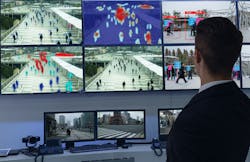This article originally appeared in the March 2020 issue of Security Business magazine. When sharing, don’t forget to mention @SecBusinessMag!
Detecting high-risk scenarios before they escalate is one of the core motivations behind the development of artificial intelligence (AI) for security applications. With AI in the quiver, operators deploying surveillance solutions can move beyond mere monitoring to leverage every video frame and piece of data available to identify threats and inform emergency response. AI is still an emerging technology; however, the benefits that its capabilities deliver are designed to minimize risks, maximize crime prevention and save lives.
In the past, video footage was archived for a short time before being overwritten. Today, segments of AI – such as video analytics, machine learning and deep learning – make use of the high volumes of data generated by IoT ecosystems to distinguish meaningful patterns in data sets, which are then translated into insights that are bolstering crime deterrence strategies around the world. This technology takes a more holistic view of data, connecting individual data points to describe what is happening, in order to quickly identify high-risk situations before they escalate.
Growing Demand
The overall market for real-time video analytics was estimated at $3.2 billion worldwide in 2018 and is expected to grow to $9 billion by 2023, according to London-based Brandessence Market Research. AI is no longer just a buzzword or a trend – it is becoming an integral component of our ever-growing datasphere.
Contrary to popular belief, AI is not the exclusive property of development powerhouses like Google, Amazon or Apple, who largely use AI to optimize speech and image recognition as well as content curation. Growing physical security concerns have also been a catalyst for steady growth in AI.
The active shooter threat has positioned schools among the early adopters of AI; in fact, they comprised estimated $450 million portion of the market in 2018, according to IHS Markit. “We are looking for (solutions) that help us to identify things either before they occur or maybe right as they occur so that we can react a little faster,” Paul Hildreth, emergency operations coordinator for Atlanta’s Fulton County Schools, told the Los Angeles Times in a Sept. 2019 interview.
AI-based video analytics also create efficiencies and offering non-security-related insights for businesses. In the retail market, for example, store owners using surveillance cameras with analytics can spot shoplifters and alert security personnel to intervene in real time. In-store analytics can also measure hotspots, visitor flow, dwell time and product display activity. Smart cities are also leveraging networks of intelligent sensors for data capture and to organize system response to incidents as they unfold, as well as improve processes like traffic flow.
Police in New York, New Orleans and Atlanta now use cameras equipped with video analytics to improve investigations. In Hartford, Conn., a police network of 500 cameras includes some AI-enhanced units that can search hours of video to find people wearing certain clothes or use license-plate recognition to identify places where a suspicious vehicle was last seen. These units can also issue loitering alarms, detect discarded objects and people as well as objects that enter a pre-defined field. These deployments represent some of the early adopters of video analytics in surveillance applications in the United States.
The Rise of Behavioral Analytics
Behavioral analytics, a subset of AI, has emerged as one of the tools to do just that. Bringing together emerging computer hardware, deep learning and the proliferation of data that make up today’s datasphere, behavioral analytics recognize hazardous situations based on the detection of certain human postures – perhaps a cashier’s raised arms or an individual crouching near an ATM.
Behavioral analytics can also be used to ensure workplace safety – for example, tracking whether employees are holding the handrails when using the stairs and sending man-down alerts. Some software can even detect a potential gunman in real time, transmitting instant alerts to first responders to help minimize the risks to students, employees and facilities.
The adoption of behavioral analytics will only grow in the future. In the meantime, behavioral analytics has increased awareness of the value of AI-fortified surveillance systems and their benefits to enterprises across several industries.
Infrastructure Needs to Keep Up
As AI analytics put surveillance solutions on the front lines of crime detection, the data storage and technologies powering these solutions must operate at the highest level. Neural networks can meet a facility’s needs by learning from video material obtained on-site; but none of that learning is able to take place if recording throughput is not highly reliable. Moreover, none of those deep learning insights will be able to benefit an organization if video frames are dropped due to low-performing storage systems.
In order for intelligent surveillance systems with AI analytics to function optimally, edge to cloud storage infrastructure must evolve. To accommodate such an influx of video and metadata from the surveillance AI, a new architecture that leverages both edge and cloud computing is needed. Storage manufacturers refer to this configuration as IT 4.0.
Deploying AI-enabled NVRs and appliances at the edge enables initial analysis to take place on-site, nearest where the data was first captured. This reduces latency and improves efficiency; thus, for example, enabling security personnel at a university to receive immediate notification if an unauthorized individual, detected by an outdoor camera, walks into a football stadium after hours.
With IT 4.0 architecture, after basic processing takes place at the edge, video and data are then transferred to a centralized environment for long-term retention and deep learning. Continuing with the education example, a university operating a public or private cloud could aggregate video and data from all surveillance systems deployed across the various departments on campus. With this holistic picture, school directors could identify foot traffic patterns on campus and other insights to aid in operations planning.
Building storage to accommodate standard surveillance systems is one thing; however, building storage to support Big Data applications that use dozens of high-definition cameras and process AI events simultaneously is quite another. Drilling down to the storage components, it is critical for integrators to consider the hard drives powering their customers’ appliances and servers. These hard drives must “write” large quantities of data, as footage is transmitted from the edge to the cloud, and “read” that same data in real time, in order to detect, identify and deliver intelligent insights.
As a best practice, integrators should swap out standard hard drives – which are only designed to operate 40 hours a week – in favor of surveillance-optimized hard drives built for 24/7 workloads. They should also look for built-in health monitoring software so that any issues that could lead to data loss are identified prior to failure. Data recovery services to add additional peace of mind for customers.
Alan Ataev is Chief Sales and Marketing Officer at AxxonSoft, a video analytics and PSIM provider. Jason Bonoan is Global Product Marketing Manager for storage provider Seagate Technology. Request more info about AxxonSoft at www.securityinfowatch.com/21125804. Request more info about Seagate at www.securityinfowatch.com/10214925.



